We have spent a very enjoyable four days in New York City. None of the ethnic restaurants disappointed us. Our experiences were quite to the contrary. Wu’s Wonton King in Chinatown has very good dumpling soup and quite good Peking duck. Marta in midtown offers good toppings for thin pizzas, and the price quality ratio of their wine list is the best I have seen in New York. Razza’s in Jersey City has excellent and truly artisanal pizza doughs, but toppings are not special. Bring your own Carema or champagne or, as we did, both. I quite liked Indian Accent, a modern Indian restaurant in midtown. They are lucky to have Mr. Lukomski, a very competent and kind sommelier/director who gives good advice on pairing Indian food with wine. We have tried five appetizers and one main course and, while none of them were under-average, we especially liked “bacon and sweet potato sharakandi, kohlrabi, crispy okra” and “wild mushroom uttapam, roast onion chutney”. Mr Lukomski suggested a Muscat Brand from Zind Humbrecht, and it worked perfectly with its crisp acidity. Another satisfactory lunch was at Katz’s Delicatessen. The place is a jungle, but it is fun, and if there is a better pastrami sandwich I don’t know about it!
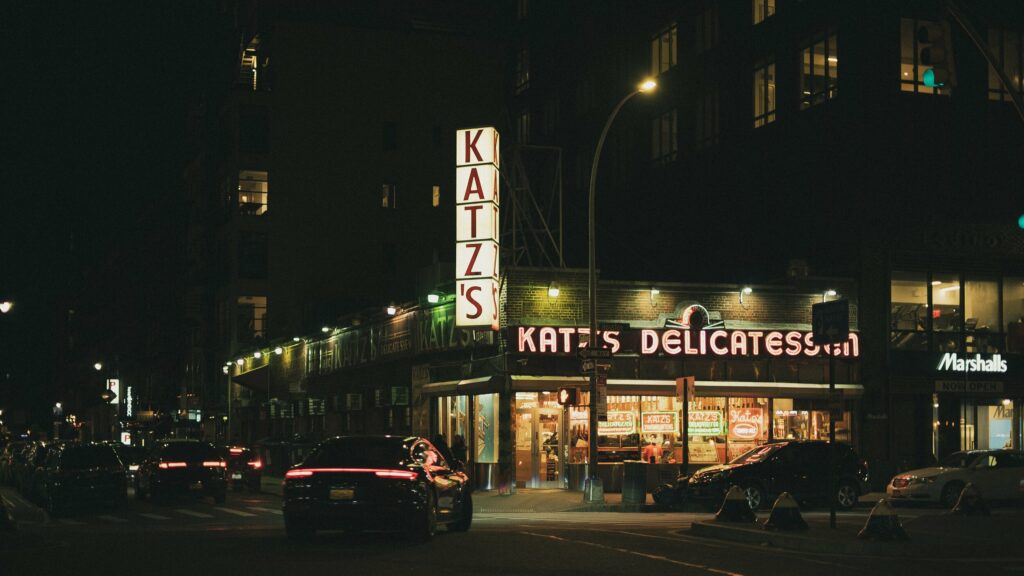
One dinner was at Lupa, for Roman cuisine, formerly part of the Batali arsenal. It is still good, lively and honest. It is quite authentic with al dente homemade pasta, but they are cooking some Roman specialties, such as “trippa alla romana” and “rigatoni con la pajata”, not as Romans but in a way not to offend those who don’t like offals. On the other hand, “mezzelune di baccalà” and “spaghetti alla carbonara” are recommended. But even more memorable were the two Italian wines: 2014 Zidarich Malvasia for cacio pepe, baccala and carbonara and 1995 Abbaza di Rosazza from Pignolo (one of my favorite “petit grands vin from Friuli) for offals and “bucatini all’amatriciana”).
Unfortunately, the two French stalwarts of New York were disappointing. It is hard to believe that the Michelin Guide awards two stars to Jean-Georges and three stars to Le Bernardin.
Let’s start with Jean-Georges (JG). I have been several times there over 20 years and always thought that the chef works with OK ingredients, but he is a great saucier. In my last visit he had removed his best dishes from the menu (scallops with cauliflower; young garlic soup with frog legs; turbot with chateau Chalon), but thenew offerings lacked character and resembled “international luxury hotel dining” targeted to (mostly non-American) business travelers.
JG now offers only two degustation menus. We chose the longer one. Problems started at the outset. Caviar with warm glazed potato and tapioca turned out to be too many little potato balls with average quality black caviar and tapioca. Maybe half as much potato with a little more tapioca would have rendered this dish more balanced. This was a far cry from “oyster and pearls” of Thomas Keller. The next course was sea urchin. It was sitting on top of black bread crostini. The sea urchin from Santa Barbara was a little bland; it was neither sweet nor minerally. The crostini was simply correct. It should have been dipped in shellfish jus to impart taste. But the most crazy idea was to top the urchin with a very strong jalepano pepper. This did not bring out the (theoretically sweet) taste of the sea urchin, but totally emasculated it.
The next two courses were hardly more successful. Tuna Ribbons is a Jean Georges classic. The composition of the marinated blue fin tuna with avocado, radish and ginger dressing can be ravishing. But this time it was not. The tuna ribbons had stayed far too long in a citrus vinaigrette before reaching the table, and this treatment had damaged the texture and rendered the “ceviche”-like dish unbalanced. The Gulf Shrimp did not suffer from the calibration problem of the similar dishes. Its sauce with chipotle, saffron yogurt, silken kabocha squash worked, but honestly the shrimp quality was too pedestrian. There exist much better species of shrimp in the US, such as the Monterey spot prawns.
The next course was the best of the night: Mozzarella ravioli with white truffle fondue. Ravioli was thin and al dente, the amount of mozzarella was just right, the “pico magnatum” crunchy and aromatic, and the amount of the butter was just right. The preparation of the dish brought out the intrinsic qualities of the exotic tuber. This dish made me think that the sous chef Joey, who was at the helm that night—and who did not know or did not want to do a chateau Chalon sauce for fish—is more apt for Italian than serious French cuisine.
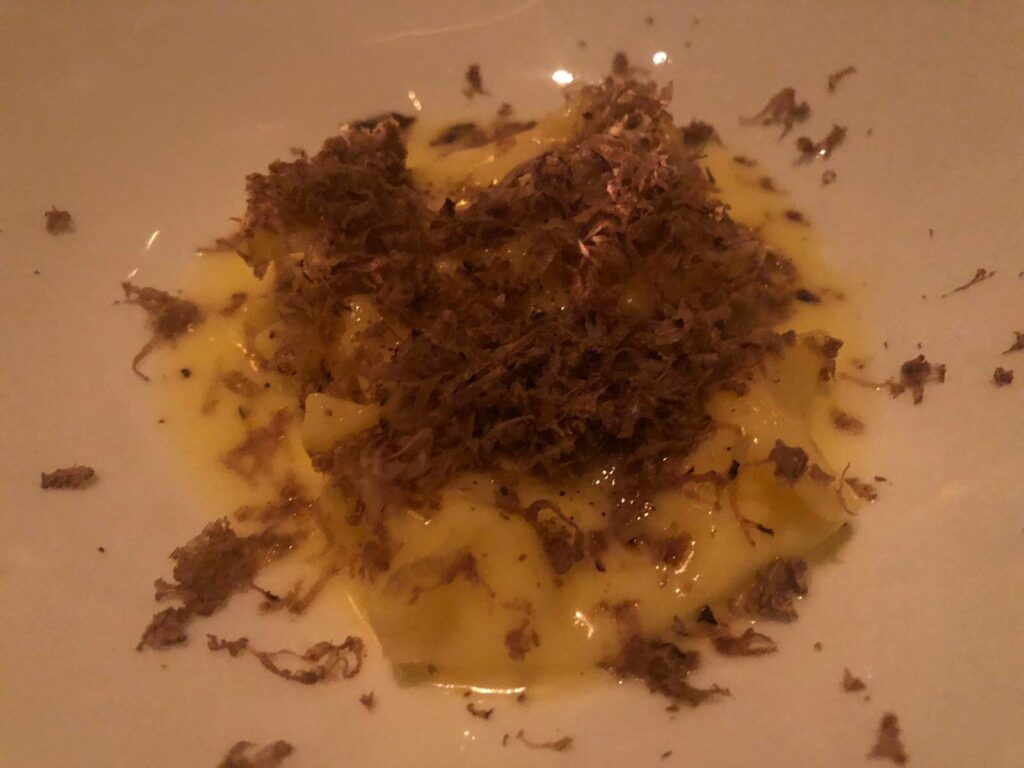
The next four courses were all fine, neither memorable nor problematic. The upstate New York foie gras is getting better, but has not reached the French level. The chef handled it properly with figs and port wine syrup. The 7th dish was “dover sole meuniere” with a beurre blanc sauce with white wine and cayenne pepper. I found the texture of the sole to not be as firm as it should be for a dover sole, but instead was too soft and flakey, more like a “slip sole”, but not as juicy, sweet, and flavorful. Was it a farm-raised fish or was the softness due to long-distance travel? I don’t know. The side dish of potatoes with onion rings in a casserole was a good example of comfort food.
Maine Lobster with Romanesco cauliflower and romesco sauce featured a very small, “farmed” American lobster. This American lobster is not on par with blue European lobster. I have had good Maine lobster, but they were much bigger, about three pounds. This one was quite cottony. The cauliflower was not caramelized as I expected, but what baffled me most was the romesco sauce. It came like a spoonful of paste consisting of chipotle, anchovy, hazelnut, and cucumber. This was a fine paste, but I could not understand why they call it “romesco” in the written menu.
The final savory course was “Herb Crusted Venison”. This was fine, especially for those who don’t like game, and prefer their meat really tender. Clearly the venison was farm-raised and lacked complexity. I did not understand why the chef crusted it not only with herbs, but also with coffee. This would have been more appropriate for wild antelope or wood pigeon. The chef served the venison with good red cabbage and a bland chestnut puree. A nice stock enriched by red wine and spices served alongside in a saucer would have been appropriate for the final savory course.
Sensing that we were not very happy overall, they brought us four desserts, instead of one desserts. Tasting all of them actually made me angry, as none of them had any gustatory value. They were more appropriate for a non-discriminating clientele who value richness, sweetness, and quantity.
The saving grace of the night was the wine I had selected: 2017 Bernadeau Les Nourissons. I had actually selected it a month earlier when the maître d’ Mr. Patrick had sent me the wine list. I had paid for it with my credit card by faxing a document to them. In the interval Patrick had left and nobody acknowledged this transaction—and other requests—that had transpired between Patrick (as the representative of Jean-Georges) and I. Yet there was a bottle left. We waited quite long for it—and they brought Saumur rouge with gulf shrimp when this was supposed to be with the venison—but finally the Bernadeau arrived. Lush, expansive, balanced and multi-layered this is a great wine which was worth getting into the trouble of experiencing it.
My overall grade for Jean-Georges does not take into account the organization and coordination problems.
Le Bernardin was a tad better, but not by much. I know this restaurant from the early days in Paris when it had two stars (Michelin was a serious guide then) and it was an excellent seafood restaurant under Gilbert Le Coze. He died at 49 years old after he and his sister moved to Manhattan. His chef de cuisine Eric Ripert kept the standards quite high for some time, but this is not the case anymore. Le Bernardin is now essentially a big brasserie, churning out sophisticated looking Instagram food for 300 or so people at lunch and dinner. The menu is too long, offers far too many choices for a place like New York where it is hard to get top quality seafood. They must be buying in bulk and relying on importers. The ingredients are so so, approximating high end supermarket quality for New York. The “innovative” aspect of the cuisine derives from modern plating and ample reliance of kelp and “dashi” broth which is very trendy and a sine-qua-non of getting the attention of the Michelin inspectors. We have tried to avoid such dishes, but not with unqualified success.
The sea urchin starter was pretty good. The sea urchins came from Maine, and they tasted clean and mineral, rather than sweet. Clearly they were de-shelled upon arriving and kept on ice. When they are de-shelled they lose some of the flavor, but Le Bernardin did a good job in preserving the original taste. They also tried to impart as much umami flavor as possible by the ample use of seaweed (algue), shellfish jelly, fresh sea beans, and sea raisins sitting on top of the sea urchin tongues. The consistency of the jelly was good. It was not overpowering and the greens were fresh and well calibrated. This was the best dish of the five that we tried. The roundly cut pumpernickel breads placed on the plate neither added nor detracted from the dish.
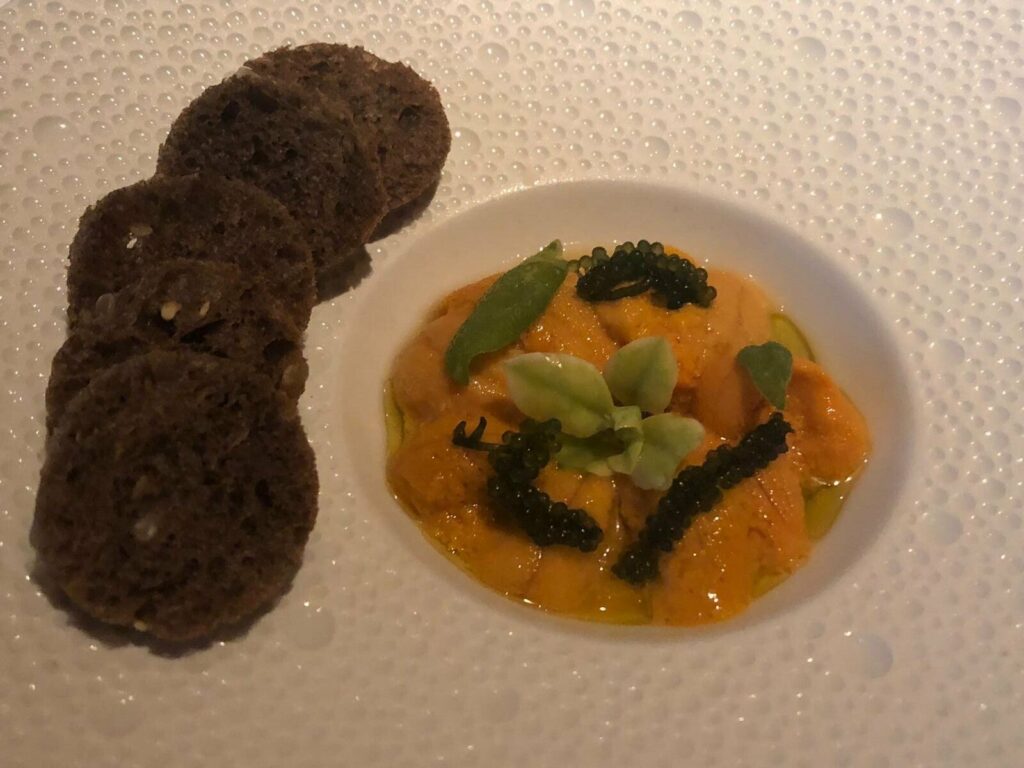
The second dish was the most problematic: Langoustines. The presentation was very pretty, a symphony of colors (orange dashi, white langoustine, green seaweed and herbs) and, also aesthetically very precise. Unfortunately, the langoustines were too mushy and inedible. I sent the dish back. The second replacement dish was edible, but still mushy, but not as bed. For the second dish, I also did not let the server pour the whole dashi (Bonito and seaweed) on the dish, as the dashi was unremarkable, not to say disappointing. The langoustines had not traveled well from Scotland, as they had lost not only texture, but also flavor. I suspect they were taken out of their shell a long time before cooking, and they sat on ice.
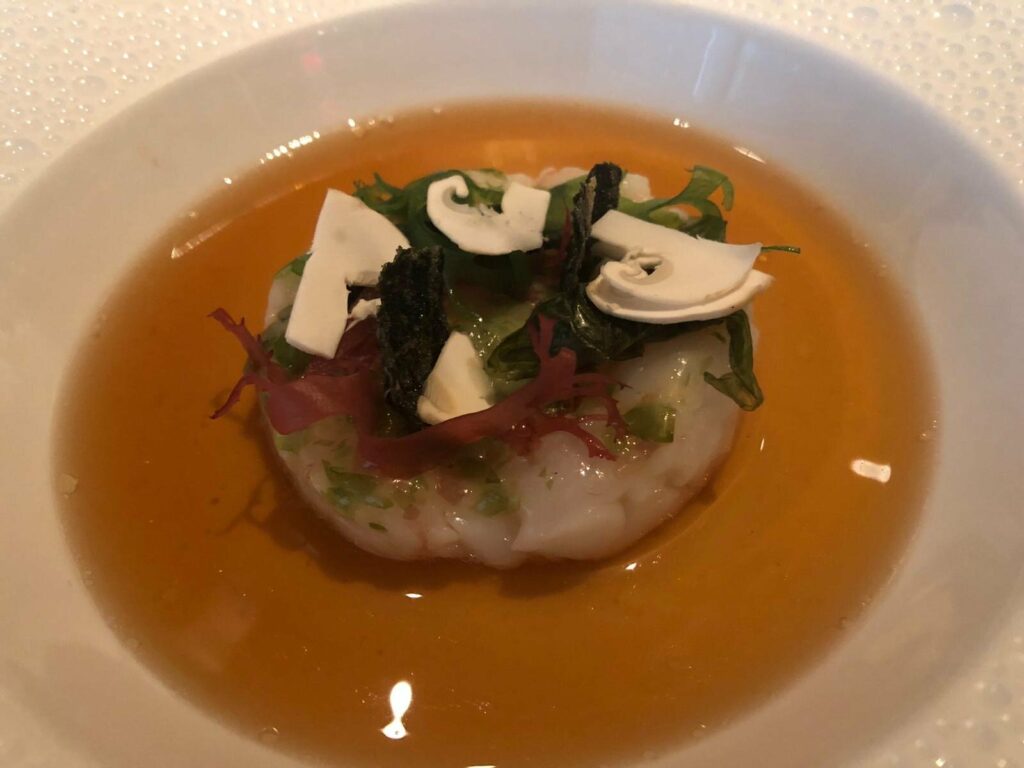
The octopus dish was fine. The octopus was roasted and finished on the grill. It was served with a red wine sauce with chorizo sausage and also with a subdued Mexican mole sauce. (They use peanuts in the mole sauce.) As far as sauces go, the two did not blend or complement one another. I think it could have been a better idea to use one or the other sauce, perfect the sauce, and then use it more generously. I do not recommend this dish, if you are familiar with real Galician octopus in Spain. You will be disappointed.
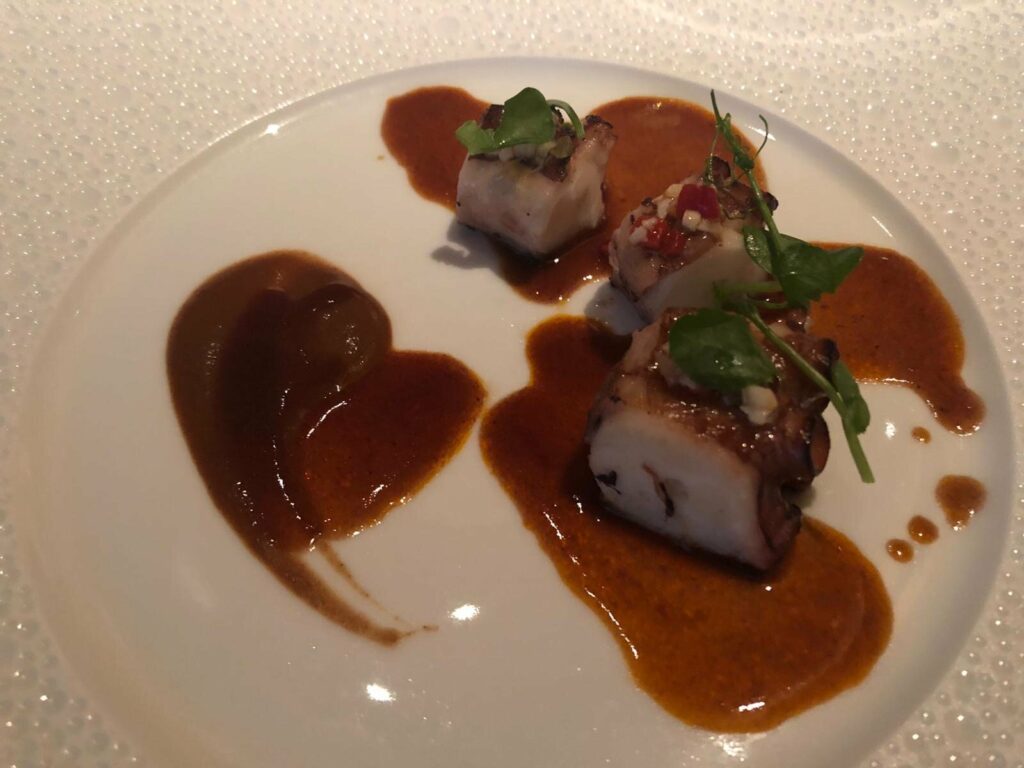
The last two dishes were fish: skate and striped bass. They were above average, but hardly more. They both looked beautiful though.
The poached skate did not taste like the “raie sauvage” I find in France. It was far too mild, and similar to what I buy in the market in the US. This means it was possibly farmed fish. It was presented with a “Thai” broth (with ginger and lemongrass) which lacked complexity. Honestly, the broth was dull.
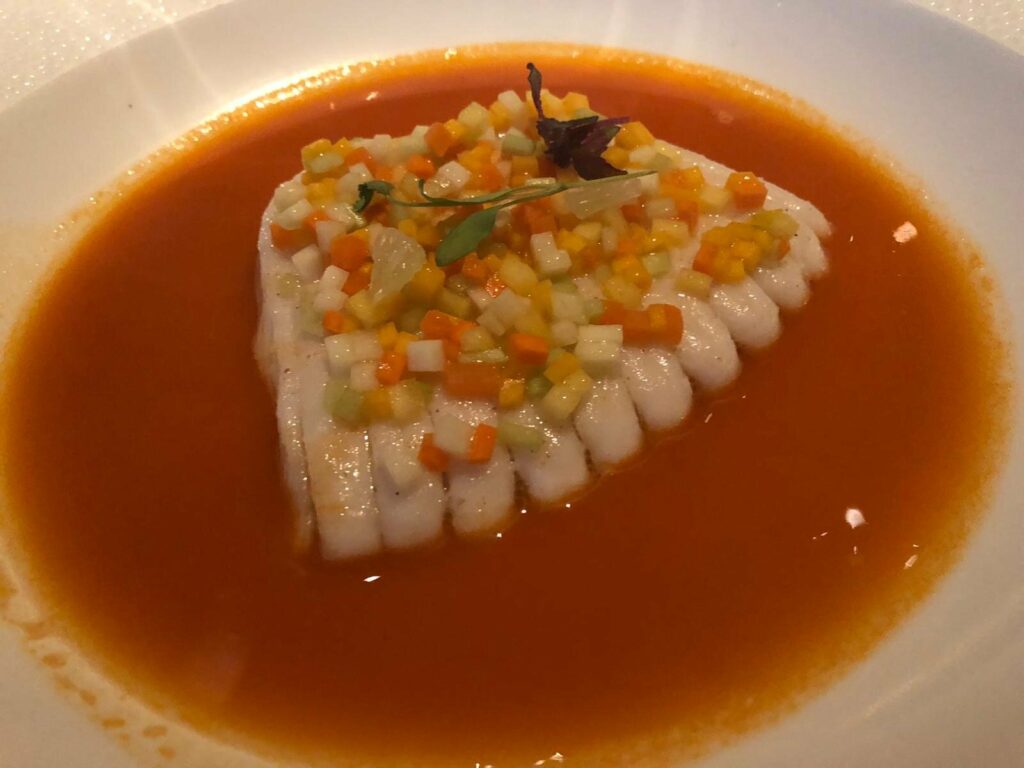
I liked the pan fried striped bass more than the skate. The fish did not have complex flavors, but it was very fresh. The olive puree and red wine sauce lacked some balance (too much olive), and it should be perfected more, but I appreciated the idea. The squash blossom filled with diced vegetables was a nice garnie.
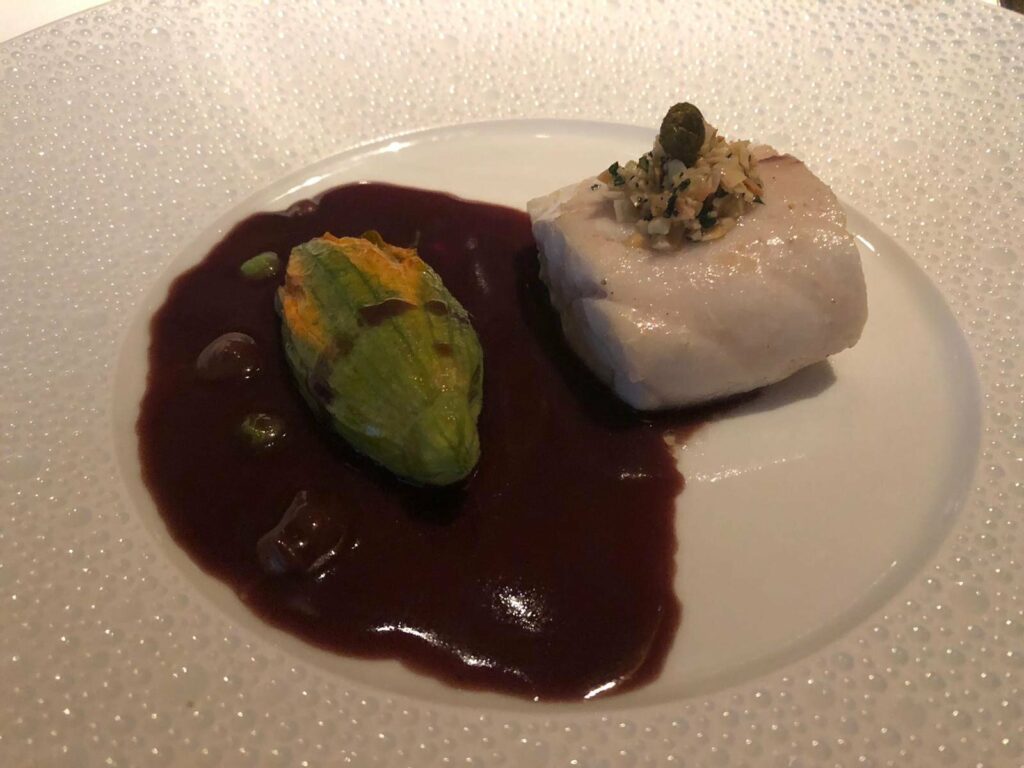
The desserts are very good at Le Bernardin. They are more focused and flavorful than the savory dishes. The dessert chef knows what she wants to do and is concocting modern desserts with classic techniques and good ingredients. We tried “corn-hibiscus” and “golden hazelnut sphere” and liked them equally.
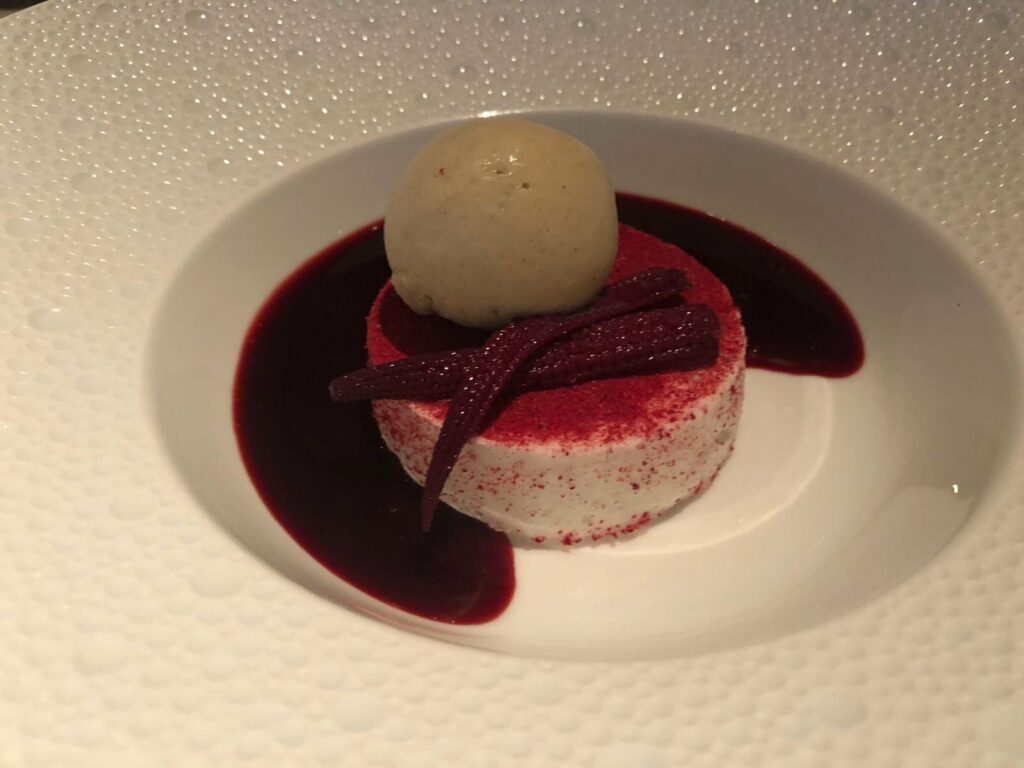
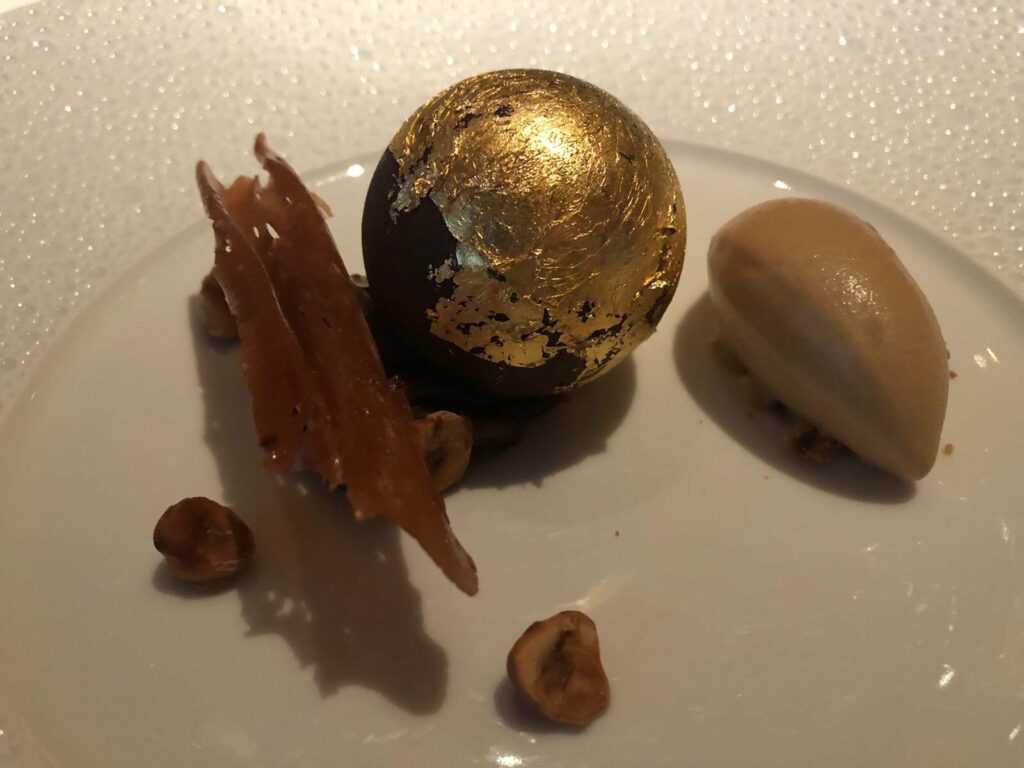
I think Mr. Ripert should re-focus on limiting his menu and should take control of the kitchen in order to cook to please his own taste buds, rather than offering everything for everybody.
Chef’s Table at Brooklyn Fare is an anomaly for the New York high end dining scene. It is on par with the best days of New York in the early ‘90s, with the impeccable Soltner (Lutece), Le Cirque, the early Daniel Boulud, the very talented Kunz (Lespinasse), and the ingredient conscious Bouley where Brooklyn Fare’s chef, César Ramirez, worked for many years. He only offers a menu degustation which is very well thought out in terms of quantity and progression. He does not offer bread throughout the meal. His ingredient selection is fantastic. He is not obsessed with being a locovore, and his imported ingredients, such as caviar, sea urchins, and langoustines, are far superior to the ones at Jean-Georges and Le Bernardin. He uses mostly pristine quality Japanese ingredients cooked with solid French technique. His dishes are deceptively simple, composed of four to five ingredients only. They are well calibrated, focused, and perfectly seasoned. The ingredients also retain their purity, and when combined together, highlight the main element of each given dish. The menu progresses from relatively simple to more complex dishes, but there is an underlying philosophy. Ramirez looks for harmony and complexity by juxtaposing not solely salt and acid, as is common in Asia, but also sweet and sour. His cooking is multi-dimensional, but not heavy. He and his chefs cook only for about 35 people and each dish receives due attention. This results in precise execution with well-timed pacing of dishes. I star what I eat and a starred dish means that at least the first three criteria of the four I outlined with Mikael Jonsson when we launched Gastroville(1) has been fulfilled. (The 4th is very rare, one does not encounter such dishes too often.) In other words a star corresponds to at least 18 out of 20 in the gastromondiale scale. Seven out of nine dishes here were starred.
I did not star the first and the last dish, but they were also good, falling just short of excellence. The first dish was tuna tartar with crispy kelp and kinome leaf. It was a nice dish.
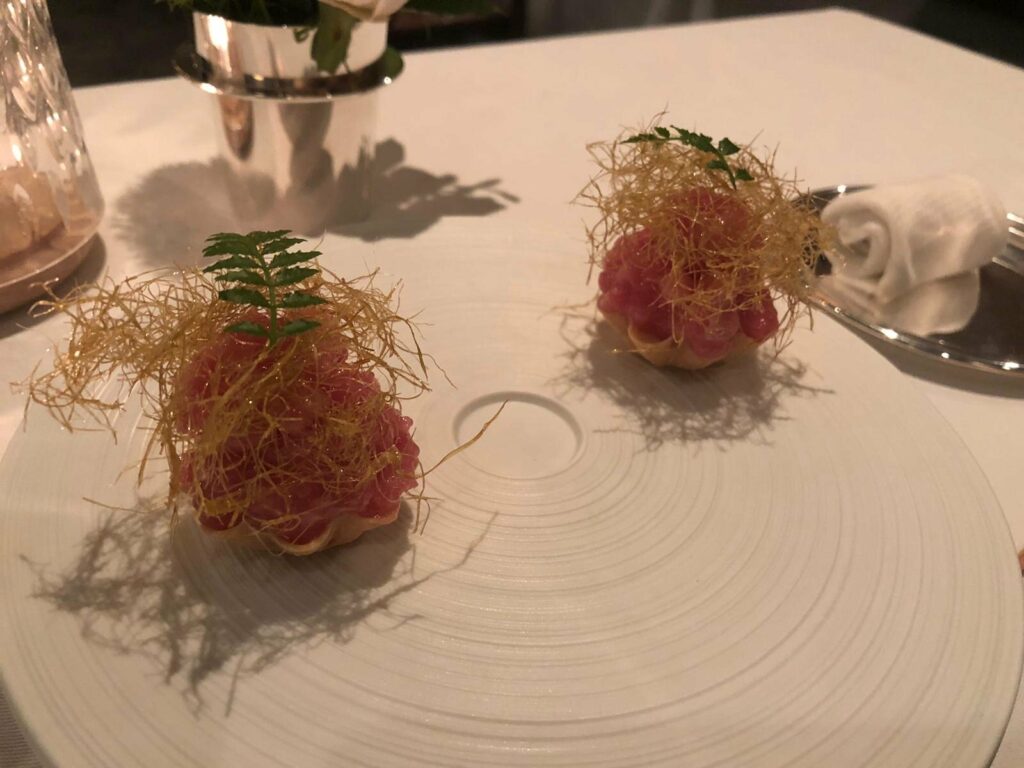
We then went on a remarkable journey with the following: Hokkaido Sea Urchins; Crab; Custard; Langoustine; Chiba Akamutsu; Wild Sea Bass; Duck; Wagyu and three desserts: Passion Fruit, Melon, and Frozen Souffle. I drank the 2007 Rayas white complimented by 2013 Agrapart champagne, a sake with langoustine, a Clerget Volnay with duck and G. Conterno’s 2015 Gattinara with wagyu.
The sea urchin quality was the best that I have tried in the States, along with the version in Saison in San Francisco. The Hokkaido sea urchins were sweet with a touch mineral. They sat on toasted brioche and on top there was a slice of black truffle. The proportions were right, and each bite exploded in my mouth. The dish went extremely well with the Agripart Champaign.
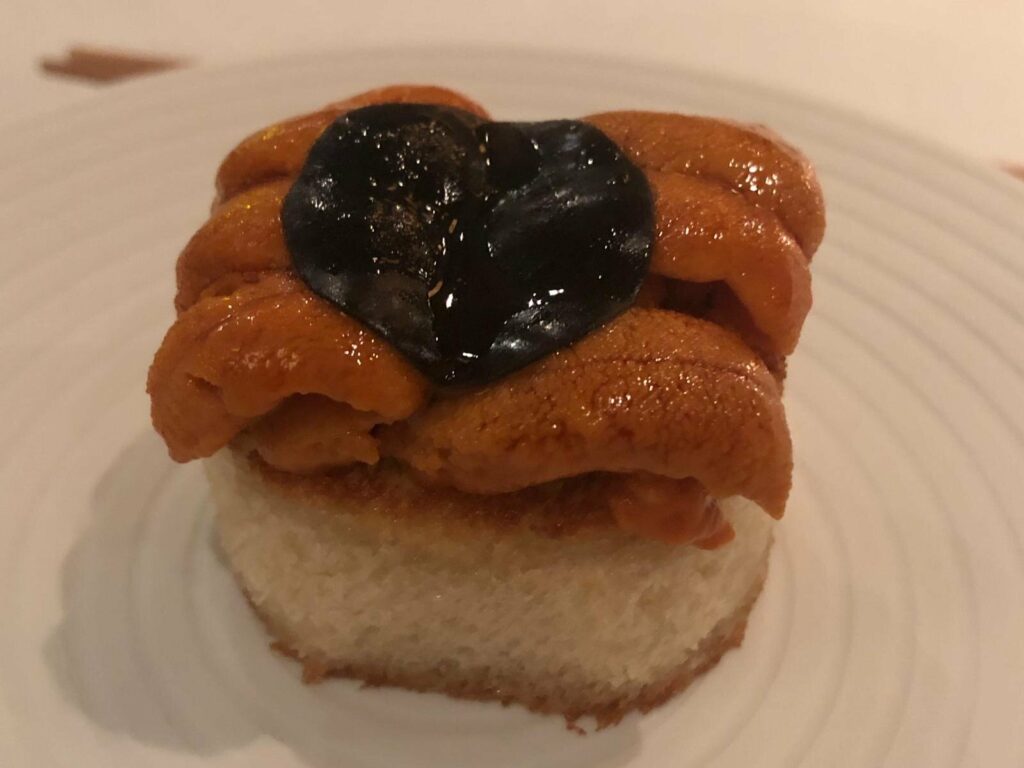
We then had the king crab from Norway which was as stunning as the sea urchins, in terms of the pristine freshness. Chef Ramirez topped the steamed shrimp with excellent quality green colored Beluga caviar from China. He also added a few shiso leaves. The caviar was possibly the best that I have had in any three-star restaurant in a long time. This is a hedonistic dish.
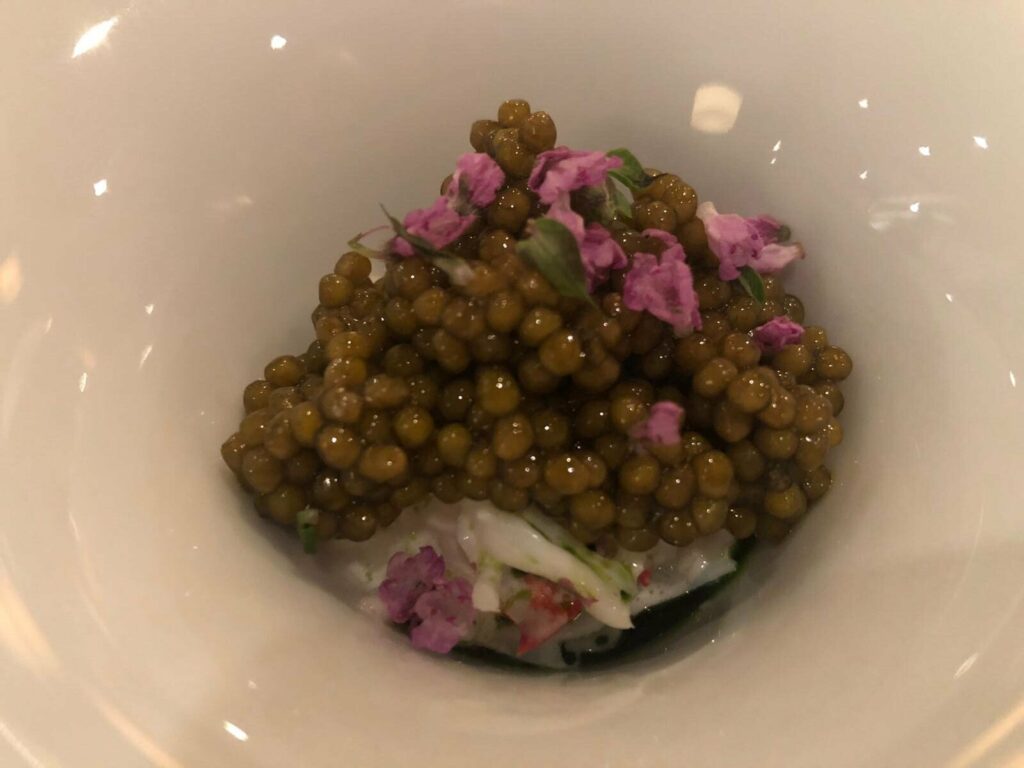
The fourth dish was equally decadent. It was a custard with silky foie gras and black truffles in a dashi. Outside Japan, I have only seen this quality of dashi at Manresa, Chef Kinch’s Los Gatos restaurant. The custard was thick, creamy, and sweet. The foie gras was very fresh, and the chef seasoned the dashi broth just right with chives and some other Japanese greens. I believe there was sliced turnip at the bottom that added a crispy contrast to the creamy texture. This dish was lush, rich, but not heavy.
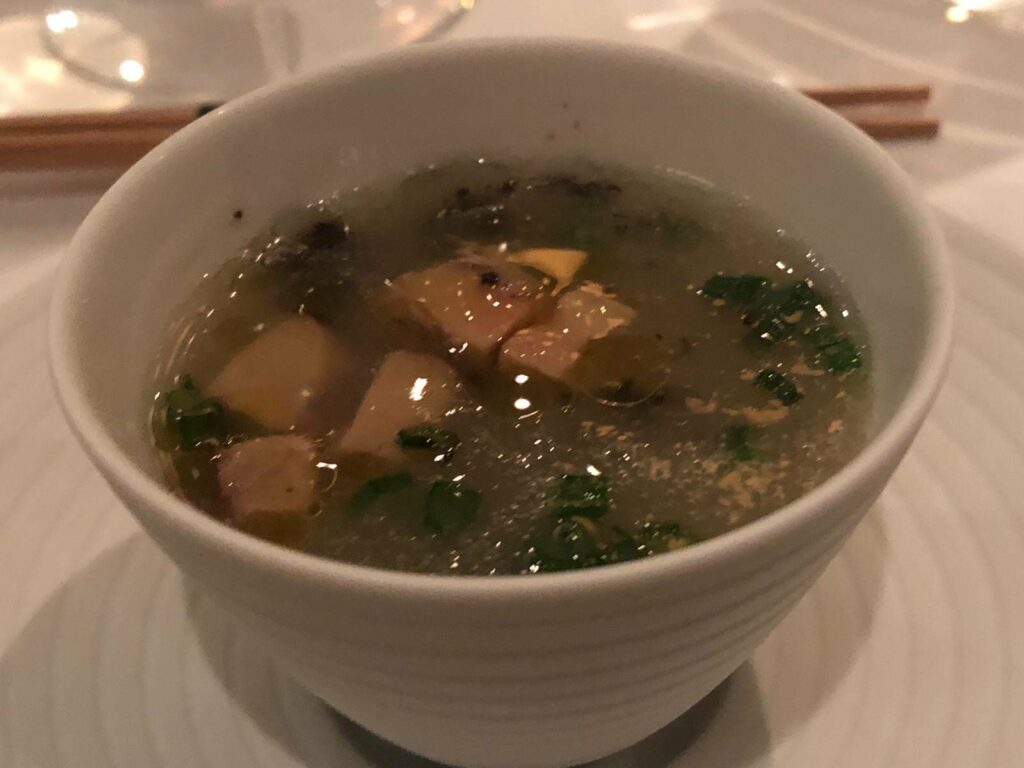
The 5th course was also a masterpiece. This dish centered on langoustines from Norway, and judging from the size, the langoustines must have been at least a half-pound each. I order langoustines all the time in Europe, but I have never seen this quality in the US. I also rarely see this level in Europe. I bet that they have been imported in their shells, with great care.(2) The chef offered the langoustines in what he called a bouillabaisse sauce. But besides the head and shell of the fish and shellfish, he had used a little vinegar, butter, and gooseberry. Overall, this was an acidulated sauce with agrumes notes, and it worked extremely well with the langoustines. I would have loved to taste this dish with Bernard Pacaud of L’Ambroisie whose langoustine dish is my favorite. Our sommelier offered a Fukuju sake with agrumes notes that married extremely well, especially with the body of the langoustine. The 2007 Rayas white, on the other hand, paired very well with the claw of the langoustine.
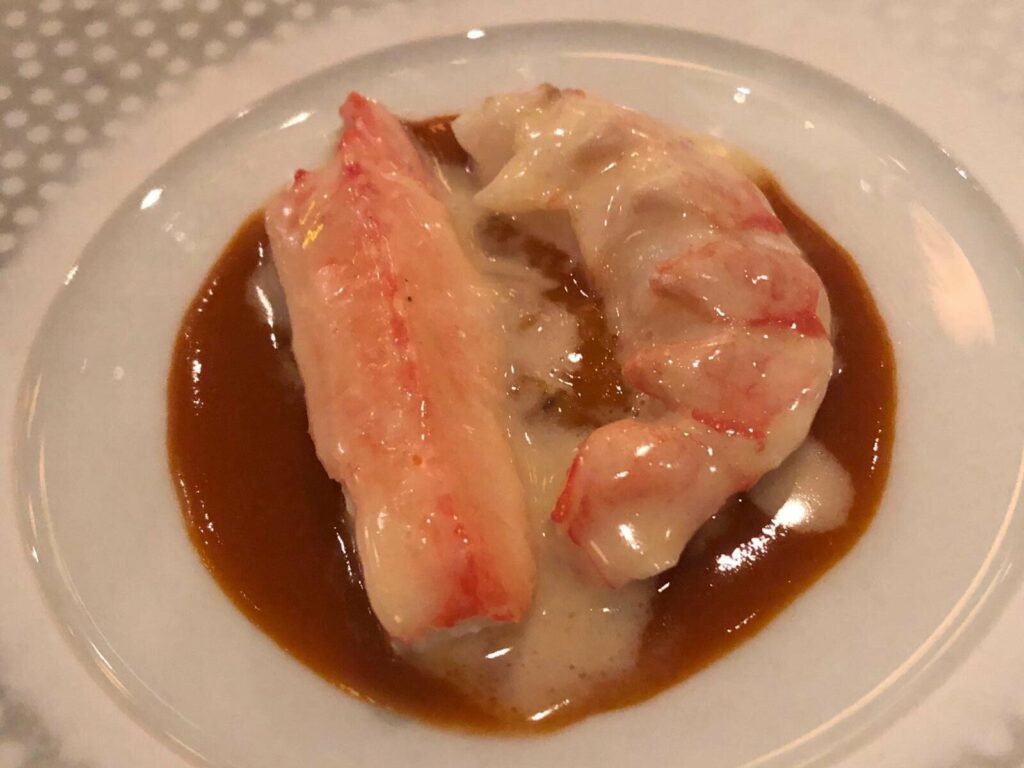
The next dish was Chiba Akamutsu, a kind of perch from Japan. This fish had a good amount of natural gelatine, when fresh, and Chef Ramirez made ample use of it in a masterly sauce. He cooked the fish with the skin, and he emulsified the gelatin of the fish to concoct an excellent sauce with fish paste, fermented yuzu, and chilli. This combination is not an easy one with which to succeed, as too many strong flavors may compete and dominate the dish. But the opposite was the case. The sauce imparted depth to the fish and with each bite one discovers a new dimension. By tasting this dish, I thought that the chef’s claim to use French techniques with Japanese ingredients is not boastful, but is actually true. Nowadays, so many young Chefs in Paris and elsewhere are trying to do the same, but are making elementary mistakes, by not balancing different elements into a harmonious whole. A visit to Brooklyn Fare is a must to see how this can be done successfully.
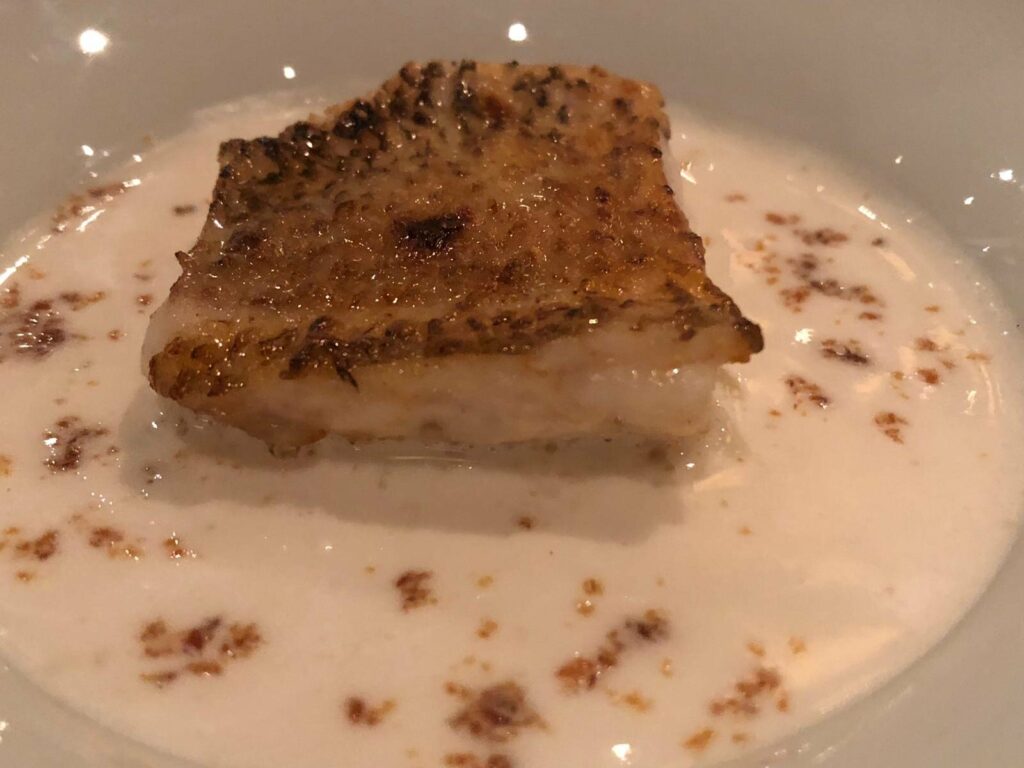
It is hard to excite the taste buds with another fish, but Chef Ramirez actually has done just that. The wild seabass with Riesling sauce and spinach was excellent. The sauce was as good as Jean Georges’ chateau Chalon sauce, in his heyday at JoJo. It is classically French, and so good! The sauce is rich, buttery, nutty, with the right tartness. I was also amazed to find this level of sea bass, which really tasted like the sea bass of my youth, prior to the onset of fish farms. This fish nowadays, even the so-called wild ones, come close to the farms to eat the leftovers, and as a result tastes bland. The sea bass in this dish had come from Holland.
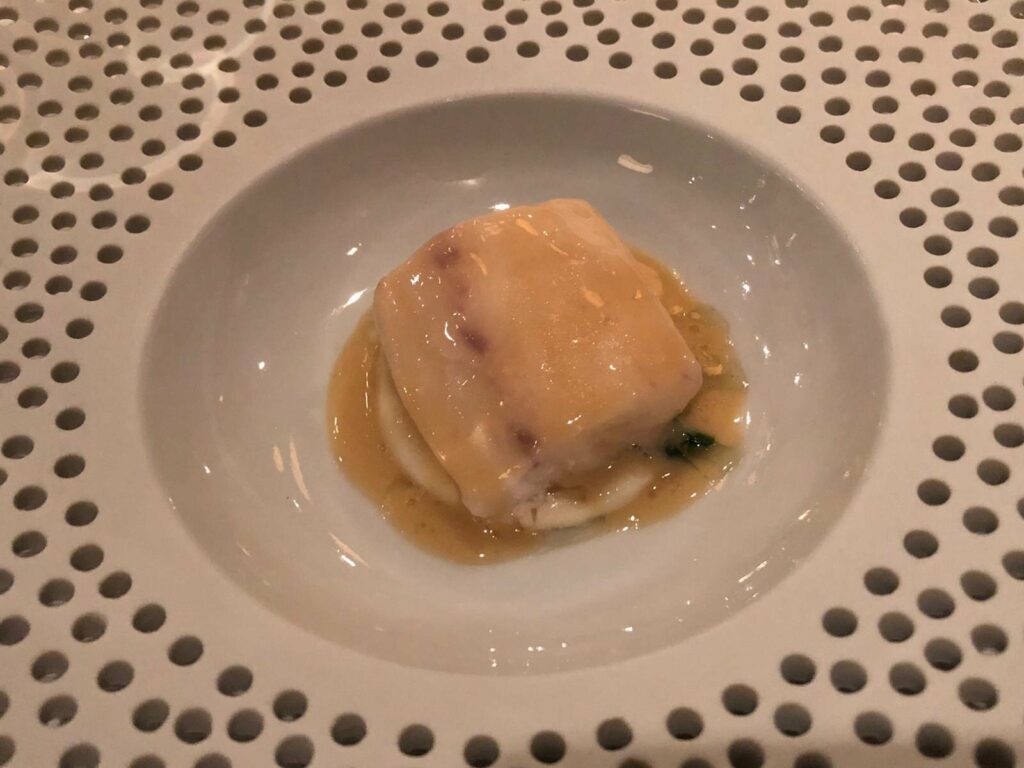
The last two courses were meat. The duck from upstate New York was also handled well and cooked with precision. The chef prepared a ravioli from the leg, to serve alongside the breast. The sauce was quite classical, with jus, red wine, and port. It was slightly acidulated, with the careful use of Asian spices. It was served with black garlic, turnips, carrots, firm chanterelle mushrooms, and cabbage.
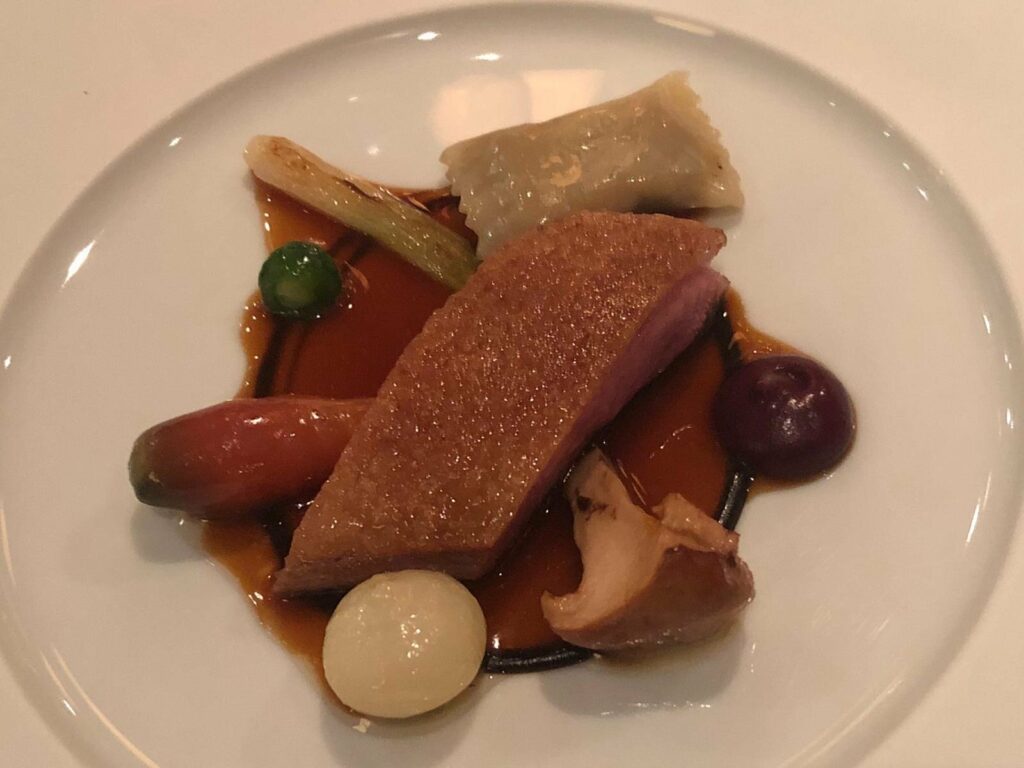
The last savory dish was 4A Wagyu. I like very much the barbequed eggplant puree and the maitake mushrooms with the wagyu, but I didn’t think that the quality of the Wagyu was special. My understanding is that Carlos doesn’t like to use a more fatty cut, but 4A wagyu does not possess the rich minerality I sometimes find in Europe, especially in Spain, from older cows. (I have had some very good steaks from different breeds, such as Black Angus, Galician Blonde, Simmenthal, Charolais, and Besos cows.) This said, this was still a good dish, and the Wagyu was properly cooked.
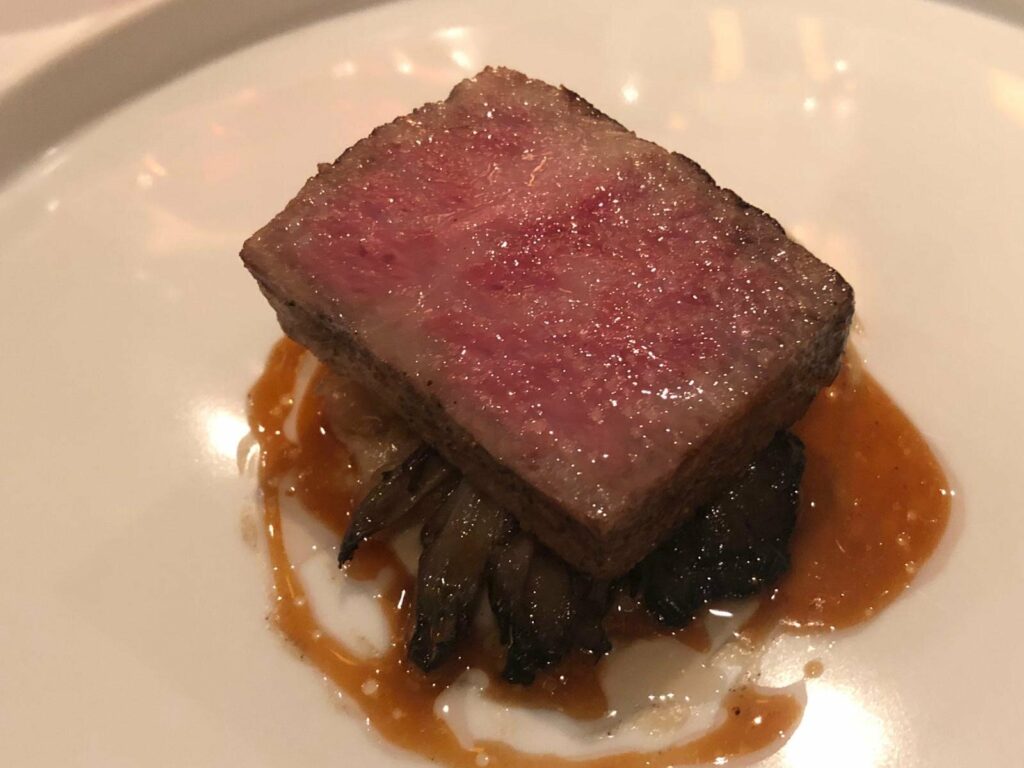
The desserts were equally well thought out and very appropriate, given the nature and the flow of the meal. First, we had a very good passion fruit sorbet with passion fruit pieces. The second dessert was even better: the melon trio: sorbet, granite, and pieces of melon. The melon was from southwest France, from a village called Philibon. Since my teens, I don’t remember seeing such a flavorful and aromatic melon. I also appreciated the Chef’s philosophy. It is not uncommon in Japan, in a great Japanese restaurant, to end the meal with an amazing fruit, such as persimmon, that is fully mature. I have only seen this done at L’Astrance, before they had three stars. Chef Barbot had served excellent cherries and strawberries in early summer. Bravo Chef Ramirez!
The last dessert was a frozen soufflé with yogurt and yuzu. This was also very good and a nice finish.
I should also add that the service is as good as the kitchen, and the sommelier-director is very kind and competent.
This meal coincided with my birthday, and it turned out to be the right selection for a birthday. We were both very happy.
Ratings
Jean-Georges 11/20
Le Bernardin 13/20
Chef’s Table at Brooklyn Fare 18/20
Notes
(1) 1. What is the quality and variety of ingredients? 2. How well do preparations respect the used ingredients, how well have the appearance and true flavors of the ingredients been enhanced and with what clarity do the ingredients shine in the preparations? 3. How much of magic touch of the chef is displayed in the preparations and how well has the chef calibrated and married tastes to achieve greatness? 4. What is the level of originality? Is it just a copy, has the chef actually tried to take another dish to a new level or is it a completely new approach with little influence of something that has been done before?
(2) See the article by Brandon Granier and me for the best live langoustines that one can find at D’Berto restaurant in Galicia.



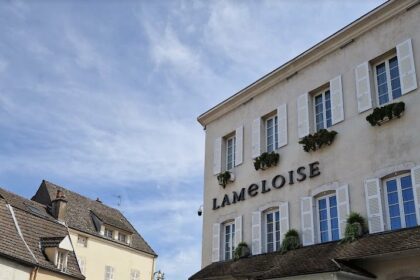
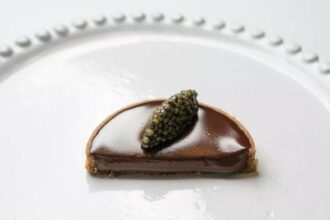
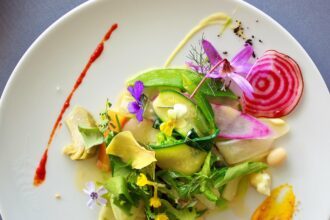
wagyu, like usa beef, is beef grain rather than grass. which gives a higher marbling than european beef. however the taste is a different profile. this is why, also, dry-ageing is a quite common technique in america these days because it’s known to add more "complex" flavours